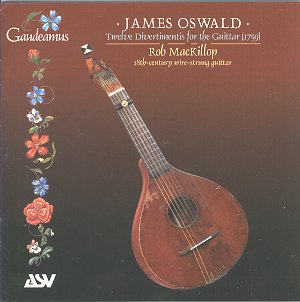James OSWALD (1710-1769)
Twelve Divertimenti For Guitar (1759)
1. Divertimento I (Amoroso-Vivace-Gavota)
2. Divertimento II (Affetuoso-Tempo di Minuetto-Gavotto)
3. Divertimento III (Amoroso-Allegro Moderato-Andante)
4. Divertimento IV (Affetuoso-Gavotta-Aria-Con Spirito)
5. Divertimento V (Cantabile-Allegro Moderato-Pastorali-Tempo di Minuetto
6. Divertimento VI (Amoroso-Moderato-Pastorali-Affetuoso)
7. Divertimento VII (Affetuoso-Andante Allegro-Adagio-Tempo di Minuetto)
8. Divertimento VIII (Affetuoso-La Chase-Tempo di Minuetto)
9. Divertimento IX (Gratioso-Musette Moderato-Andante con Spirito)
10. Divertimento X (Amoroso-Allegro Moderato-Andante-Adagio-Giga)
11. Divertimento IX (Andante-Allegro Moderato-Cantabile)
12. Divertimento XII (Largo-Moderato con Spirito-Amoroso-Giga)
 Rob Mackillop (18th
Century wire-strung guitar)
Rob Mackillop (18th
Century wire-strung guitar)
 ASV CD GUA 221
ASV CD GUA 221
Crotchet AmazonUK
AmazonUS

When reviewing music by a composer that is new to me I make it a policy not
to read the inlay notes of the disc so as not to come to any preconceived
attitudes regarding the music. So my first impressions of these "Twelve
Divertimentis" by James Oswald played by Rob Mackillop on a 18th
century wire-strung guitar was that of the composer not having a formal musical
education but of a simple but talented minstrel perhaps from Scotland or
Ireland who, given the rustic feel of his music, with its dance like movements,
was employed to provide the music for local village dances.
As it turned out I was only right about his place of birth as indeed James
Oswald was born in Scotland. He came from a poor but musical family and
eventually rose to the elevated position of Chamber Composer to King George
III of England. The fact that his "Twelve Divertimenti" date from 1759 is
remarkable in as much that he seemed to retain an affinity for rural Scottish
influences.
Even with their folk-like feeling the "Twelve Divertimenti" are highly
structured, each one beginning with a slow section usually an "Amoroso" or
an "Affetuoso" and mostly ending with a more lively movement, a "Gavotta"
or "Giga". Although these works are not long in duration (the longest being
6 minutes 4 seconds) the variety of themes make them a musical delight.
As might be expected the wire-strung guitar produces a brighter sound than
the conventional classical guitar which tends to limit its pallet of timbres,
and although Rob Mackillop does discuss the subject of tonal variation in
the inlay notes the performance does not abound with them. However his use
of dynamics is excellent, the pianissimos are just that and the
fortes loud enough without forcing the natural limitations of the
instrument.
Rob Mackillop's genuine enthusiasm for this music is apparent, not only from
his playing but also from his highly informative inlay notes, which reveal
him to be a scholar of the subject. He should be commended for his research
into the repertoire of this little known area of the guitar's history.
Andy Daly

